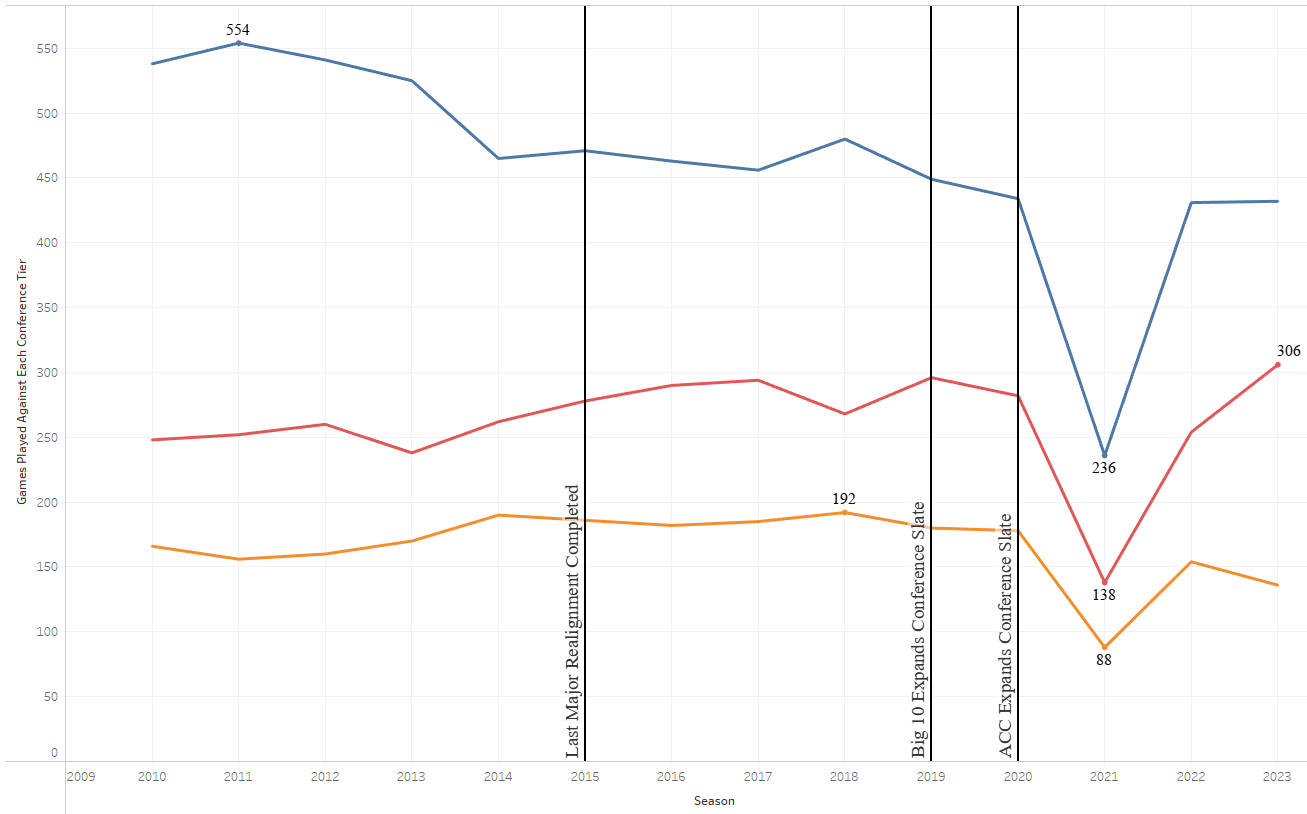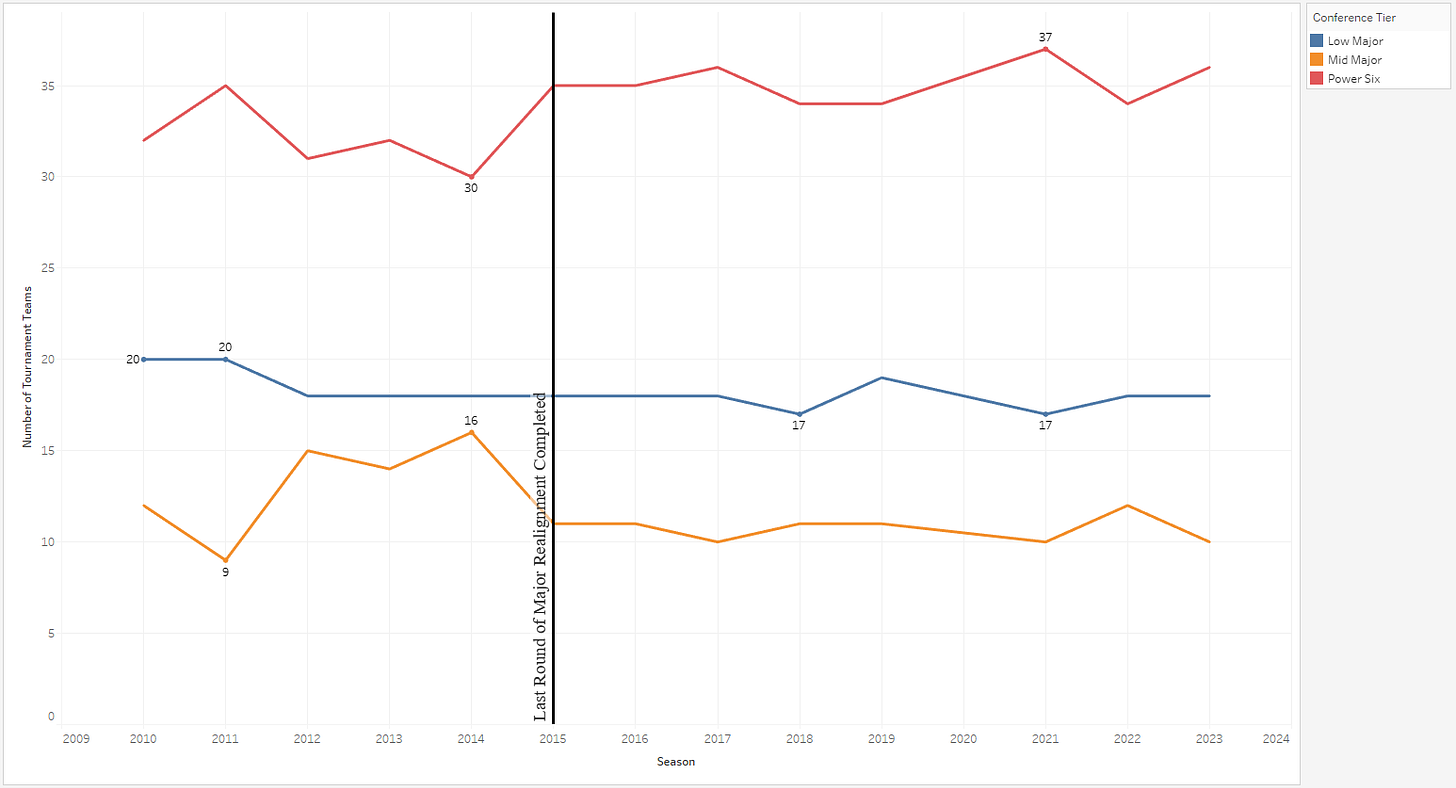NCAA Tournament Expansion and Mid-Majors
Key Takeaways
NCAA Tournament expansion to 96 teams would likely create greater opportunities for mid-major teams.
Conference realignment makes expansion even more urgent.
The NCAA has toyed with the possibility of expanding the NCAA Tournament beyond the current 68 team format for several years, and, once again Dan Gavitt revealed that the men’s tournament committee is reviewing that possibility. Proponents, like Loyola Marymount head coach, Craig Pintens, say that expanding the tournament will create greater opportunities for mid-major teams. Opponents argue that extra at-large bids will go almost exclusively to top tier teams that had bad seasons.
To evaluate the merits of each argument, let’s start by looking at the 28 teams that would have gotten into the 2023 Men’s Tournament in a 96-team bracket. If we follow Coach Pintens’ suggestion that the NCAA Tournament would absorb the NIT, then that would leave us with a tournament field consisting of the following conference tier1 breakdown:
Based on this data, expansion out to 96 teams would increase exposure for teams outside the Power Six. But humor me, if you will, because I want to take a look at a more fundamental problem: realignment, and the scheduling issues it will create.
As the ACC, Big 10, Big 12, and SEC add additional schools, it seems unlikely that there will be much room for mid-major teams like Virginia Commonwealth (VCU) and San Francisco to schedule quality matchups against Power Six schools. The problem is twofold.
First, Power Six teams will be even more reluctant to schedule games against dangerous but uncertain mid-major opponents. Each of the Big Four (ACC, Big 10, Big 12, and SEC) will likely have 10-14 top 100 teams in each of them. Adding non-conference games against mid-majors will do little to improve their resume; but losing might crush their tournament hopes.
Second, within the next four or five years, the Big Four may elect to expand their respective conference slates to 22 or even 24 games, to ensure that enough double-headers are played. This would essentially remove the opportunity for mid-majors to schedule matchups against the Big Four.
The graph below helps illustrate both of these problems.
Gradually, as Power Six conferences expanded and increased the number of intra-conference games, the number of games they played against mid-major conference teams fell off.
Both of these problems cut opportunities for mid-major teams to build a tournament resume that will allow them to receive an at-large bid. The results show up in the number of tournament teams from mid-major conferences, as the chart below illustrates. Since 2015, when the last round of major conference realignment was completed, more bids have gone to Power Six conferences, and mid-majors are getting squeezed out of the NCAA Tournament
There are other options to hopefully increase the number of mid-major teams in the NCAA Tournament. The selection committee could restrict the number of at-large bids each conference could receive. This would have the advantage of ensuring that no single conference will flood the tournament with bids and grab an outsized share of the pool of money doled out. However, the likeliest outcome of this scenario would just even out the number of teams between Power Six conferences. It will also draw the ire of those Power Six conferences who will feel the NCAA is getting heavy handed.
Another option would be for the NCAA to set stricter scheduling guidelines. Some possibilities here include:
Limiting the number of nonconference home games each team can play.
Requiring each team to play at least two teams from each conference tier.
Restricting the number of conference games a team can play.
The penalty for failing to comply with these guidelines would be exclusion from the NCAA Tournament. However, Power Six conferences now wield immense power. It is quickly becoming possible that the Power Six would breakaway should the NCAA get too heavy handed with scheduling and tournament bids.
It seems that expanding the NCAA Tournament is the best way to ensure greater opportunities for mid-major programs. Other options discussed here may be more appealing, but the backlash against the NCAA (possibly from all sides) renders them unfeasible. One thing seems certain, if there is no change, the Power Six conferences will continue to grab more at-large bids.
Power Six conferences are the ACC, Big 10, Big 12, Big East, Pac 12, and SEC; mid-major conferences are the American, Atlantic 10, Missouri Valley, Mountain West, USA, and West Coast; low-major conferences are all others.







